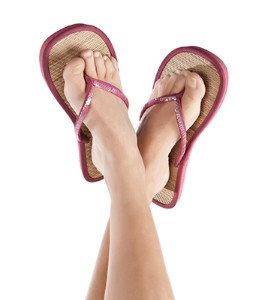 We put a great amount of pressure on our feet every day. Thus, they are quite prone to injury. Stretching the feet is an effective way to prevent affliction. There are some simple exercises to perform in order to keep the feet flexible. To begin, sit on the floor with your legs straight in front of you. Place a towel around your toes and pull them toward yourself. This should be a useful stretch for the whole lower half of your body. Next, find a chair, and attempt to lift the towel off of the ground with your toes. You should find that this strengthens the feet muscles. Another stretch while in a chair is to practice spreading your toes apart for a few seconds at a time. If you have steps in your home, you can put your toes on the edge of your steps, while alternating between lowering and lifting your heels. Finally, you can roll a small ball on the bottom of your foot while standing on a flat surface. Remember that all stretches and exercises must be done within moderation. If you have any questions, or would like additional stretching routines, be sure to contact a podiatrist.
We put a great amount of pressure on our feet every day. Thus, they are quite prone to injury. Stretching the feet is an effective way to prevent affliction. There are some simple exercises to perform in order to keep the feet flexible. To begin, sit on the floor with your legs straight in front of you. Place a towel around your toes and pull them toward yourself. This should be a useful stretch for the whole lower half of your body. Next, find a chair, and attempt to lift the towel off of the ground with your toes. You should find that this strengthens the feet muscles. Another stretch while in a chair is to practice spreading your toes apart for a few seconds at a time. If you have steps in your home, you can put your toes on the edge of your steps, while alternating between lowering and lifting your heels. Finally, you can roll a small ball on the bottom of your foot while standing on a flat surface. Remember that all stretches and exercises must be done within moderation. If you have any questions, or would like additional stretching routines, be sure to contact a podiatrist.
Stretching the feet is a great way to prevent injuries. If you have any concerns with your feet consult with one of our podiatrists from Westside Podiatry Center, LLP. Our doctors will assess your condition and provide you with quality foot and ankle treatment.
Stretching the Feet
Being the backbone of the body, the feet carry your entire weight and can easily become overexerted, causing cramps and pain. As with any body part, stretching your feet can serve many benefits. From increasing flexibility to even providing some pain relief, be sure to give your feet a stretch from time to time. This is especially important for athletes or anyone performing aerobic exercises, but anyone experiencing foot pain or is on their feet constantly should also engage in this practice.
Great ways to stretch your feet:
- Crossing one leg over the others and carefully pull your toes back. Do 10-20 repetitions and repeat the process for each foot
- Face a wall with your arms out and hands flat against the wall. Step back with one foot and keep it flat on the floor while moving the other leg forward. Lean towards the wall until you feel a stretch. Hold for 30 seconds and perform 10 repetitions for each foot
- Be sure not to overextend or push your limbs too hard or you could risk pulling or straining your muscle
Individuals who tend to their feet by regular stretching every day should be able to minimize foot pain and prevent new problems from arising.
If you have any questions, please feel free to contact one of our offices located in Liverpool, Camillus, Skaneateles, Oswego, and Cicero, NY . We offer the newest diagnostic and treatment technologies for all your foot care needs.





